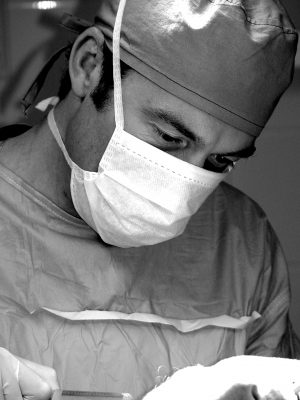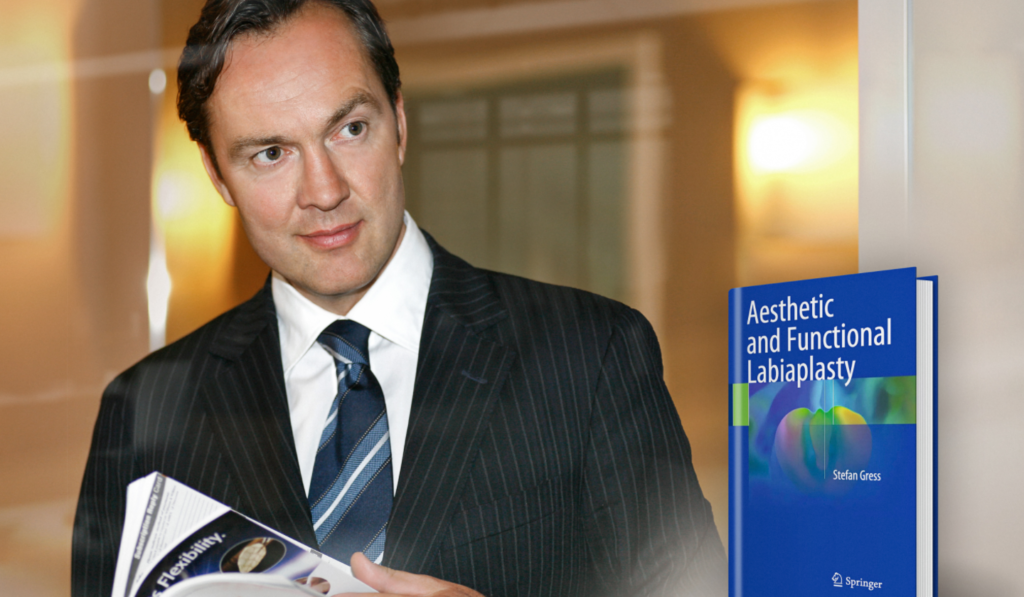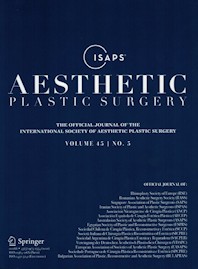
Prof. asoc. Dr. Stefan Gress
Plastic & Aesthetic Surgeon






Labia Reconstruction
Professor Gress is one of the top specialists internationally
What would you like to find out more about?
Labia Reconstruction
have surged in popularity in recent years,
especially labia minora reduction surgery.
So, you think it is all over and you have put everything behind you. But the result has turned out a lot different than you expected, different from what was discussed or even promised. Perhaps it’s much worse than before, or even mutilated.
Sadly, it has to be said that the biggest risk of labia reduction surgery relates to the incompetence and inexperience of the surgeon. These operations are frequently offered casually, even though the surgeon has not mastered the surgical standards and techniques. A labia reduction is often described as a “quick fix” in the sense of “it won’t take us long to do that too”. And the result lives up to this.
Labia minora reduction has been the most common procedure on the spectrum of female intimate surgery at our clinic for many years, followed by vaginoplasties. We have the most experience in this field worldwide. Despite the routine nature and safety of this operation, a labia reduction surgery takes around two to two-and-a-half hours for us to complete. You are quite within your rights to be suspicious if you are told elsewhere that it would be much faster…
There are a whole host of factors that can go wrong and impair the result. That is why the reconstruction, in other words the restoration of the labia minora, is no routine procedure. It is a very individual procedure that not only corrects previous mistakes but also gives you the desired result that you had hoped for when you first decided to undergo a labia reduction!
An unsuccessful operation always brings considerable disappointment and sometimes even traumatic effects and severe mental stress. It is now even worse than before. You probably regret deciding to go ahead with the procedure in the first place.
You may be experiencing pain, sensory disturbances, a deflected urinary stream, exposure of the vaginal opening with recurring inflammation of the vagina, burning, itching, skin irritation, etc.
Whilst some problems can be resolved or improved through reconstructive surgery, others cannot or are extremely difficult. It is often the case that this cannot be achieved in one surgery alone.
Here are the most common errors
1. “Microphallus” / small penis deformity
This is the most common error. The labia minora have only been reduced below the clitoris. There is still an overhang in the area adjacent to or above the clitoris. This then resembles a microphallus.
Prospects of corrective surgery: mostly successful
2. Overcorrection
The labia minora may shrink a little more once the swelling has gone down after the operation. This should be taken into consideration before the procedure. In an ideal scenario, they have a height of about 1 cm (measured from the base) but can be more or even less, if desired.
Prospects of corrective surgery: dependent on the remaining length of the labia minora
3. Undercorrection
The removal of too little tissue is not so much of a problem as further reduction is always possible. Although this is annoying, it is not usually a problem. In most cases, undercorrection affects the area above the clitoris. In this case, reductions are usually not performed due to the fact that this could impair sensation. However, since the sensation of the clitoris comes from within the deeper tissue, there are no restrictions on sensation.
4. Frayed wound edges
This is primarily due to a poor suture technique and the use of suture threads that are too thick.
5. Gaps
Surgical techniques, such as the wedge resection, often leave conspicuous scars; the wound edges are sometimes under so much tension that gaps may appear.
6. Pronounced asymmetry
As a general rule, the two labia should be the same length after the procedure. It is always very difficult to achieve exact geometrical symmetry as the labia may heal differently, even when precise measurements were made prior to the procedure. The results should, however, appear symmetrical in all cases.
7. Contour defects
If the excess tissue is not removed along a previously drawn line, but freehand without measurement or marking, the wound edges may turn out wavy, leading to a defect in the contours. Correction is not usually difficult.
8. Mixed picture
It is, of course, possible for the issues and findings mentioned above to occur in combination to varying degrees.
You can find images of these errors on our pictures page (after registering/requesting the password).
POSSIBILITIES OF CORRECTIVE SURGERY
There should be two aims in this regard:
- To resolve the issues
- To achieve the original desired result
Correction
Generally speaking, frayed wound edges can be smoothed out, contour defects and gaps can be closed, and undercorrection can be revised. However, it is more difficult to replace tissue when too much has been removed.
Reconstruction is more complicated in the case of overcorrection or a microphallic deformity and a complete repair may not always be possible.
There are essentially two possibilities for restoring the labia minora:
- Reconstruction using excess tissue above the clitoris
- Reconstruction using vaginal skin
- This technique consists of freeing two longitudinal flaps lateral to the shaft of the clitoris and rotating them downwards to be inserted and fixed into the remaining labia minora tissue.
- If the previous approach is not possible, especially when there is no available excess tissue above the clitoris, the labia minora have to be reconstructed using vaginal skin.
Skin grafts are not considered for reconstruction purposes as they are not sensitive and the appearance is less aesthetically pleasing.
Video surgical technique 1
Video surgical technique 2
TIP
As with any surgical procedure, a difficult healing process may have a negative effect on the expected result. It is important not to put the area under stress too soon after labia reduction as the wound may not heal properly and may cause visible changes. You should therefore follow your doctor’s instructions without fail and avoid any kind of friction, in particular sexual intercourse, for at least six weeks after the operation. The most important thing you can do is research and choose your surgeon with the greatest care as the majority of problems and the most severe complications arise as the result of a botched operation.
Unfortunately, it is much more difficult to achieve an optimal result if damage has been caused in a previous surgery.
However, the aim is to achieve your desired result and resolve any issues (pain etc.).
For more information on the ideal shape and the different techniques, please see the following:

Here is some important medical information about the function and structure of the labia:
The small (inner) vaginal lips seal the vaginal opening and prevent infections from developing inside the vagina, and other conditions.
The large (outer) vaginal lips enclose the small vaginal lips and offer mechanical protection.
The clitoris is the only organ that purely serves the purpose of sexual stimulation
The labia cover and seal the vaginal opening, protecting the vagina from drying out and stopping foreign bodies and pathogens from making their way in. Additional mechanical protection is offered by the fat pads of the labia majora.
The labia minora extend from the mons pubis towards the anus, encompassing the clitoris and the vaginal opening. The part of the labia adjacent to the clitoris is also referred to as the “clitoral hood”. In terms of morphology, the labia minora are equivalent to the foreskin of the penis. They are of secondary importance for sexual stimulation.
The term clitoris is commonly used to refer to a small, pea-shaped anatomical structure located a little above the urethral opening. However, the clitoris is not spherical but rather band-like in shape, similar to a small penis, with only the tip (glans clitoris) protruding and being visible. Its shaft (corpus clitoris) extends in a deeper layer across the pubis and is thus not visible. The clitoris is responsible for sexual stimulation.
Labia reconstruction is performed under local anesthesia. It is important that you do not take any blood-thinning medications (e.g. aspirin, etc.) 14 days prior to the surgery. Please bring all relevant documents with you to the preliminary consultation, if possible including the surgical report from the initial operation, so that we can get a good idea of what exactly happened during the previous surgery.
Before the surgery
If the procedure is being performed under local anesthesia, no special preparation is required. If the procedure is being performed under general anesthesia or twilight sedation, you should fast, i.e. refraining from eating, drinking, and smoking, for at least six hours prior to your surgery.
You should stop taking medications that affect coagulation, e.g. aspirin 100 mg, etc., 14 days prior to the surgery. Please completely shave your genital area before the procedure.
You will be given a delicate work of art. Reconstructive surgery usually involves mobilizing and displacing tissue. That is why circulation is a primary concern. Please do not smoke! Cooling and compression as well as follow-up treatment are determined on an individual basis depending on your procedure and healing process.
Avoid mechanical friction as much as possible for eight weeks after the procedure. Please also note the following:
After the surgery
After the surgery, you can rest at our practice.
Please do not drive home or back to your hotel yourself. Get someone to pick you up or we can call a taxi for you. Cool the area and rest. You should walk as little as possible. You may experience a mild burning or pressing sensation, especially during the first night. This is normal. However, some patients feel it more than others and, despite the pain medication prescribed by us, a few patients may experience significant discomfort. The sensation typically disappears or greatly improves after the first night. On the first postoperative day, the wound is checked and the dressing is changed at our practice.
After the third day, you can start showering again, but may only use clear water and no soap during the first week. The sutures are absorbable and do not need to be removed. Absorption of the suture may sometimes be associated with severe itching, which can be alleviated by using special creams or ointments.
The surgery will only affect your daily activities for a short time. Depending on your profession, you may be able to return to work as early as two to three days after surgery. It is very important that you try to avoid any friction and forces acting on this area for eight weeks following the procedure: no sexual intercourse, jogging, cycling, horse riding, etc.! Likewise, tampons may only be used again after this period of time.
To optimize the healing process, you should place a compress between the labia so that they do not touch. You should do this over a period of two weeks.
You will be provided with the cell phone number of Prof. Gress so that you can contact him any time should you have any questions or experience an emergency.
Prof. Gress has published most of his medical publications with Springer Verlag.
His textbook on correcting the outer female genital region entitled „Aesthetic and Functional Labiaplasty“ was published in 2018.
This book describes his techniques for reducing the labia minora, primarily the “composite reduction labiaplasty”, and techniques for correcting the labia majora and the mons pubis. This textbook is now the standard for colleagues in this field throughout the world.
Publications by Prof. Gress:
(click for further information)
Good to know
All important questions
Costs for labia reconstruction
The costs for labia reconstruction depend on the type and duration of the procedure and range between EUR 3,000 and EUR 12,000.
If the procedure is being performed under twilight sedation or general anesthesia, the anesthetist fees are charged in addition to the usual cost of the surgery.
The fee for the operation must be settled before the day of the surgery. A deposit of EUR 500 is required to secure an appointment for surgery Operating time and costs.
Hotels
We will be glad to help you find a suitable hotel of any kind. We have a partnership with Hotel Vier Jahreszeiten Kempinski, Munich, which means our patients are offered more favorable rates. They should, however, refer to our practice when booking the hotel or make the booking with our assistance .
Personal advice and information
You can request further information or arrange an appointment. This is non-binding and free of charge. Call +49 (0)89 24 22 39 22 for advice on your own surgical needs. This personal advice service is non-binding and free of charge.
Financing
Is it possible to get any financing?
Please understand that we are unable to provide any financing ourselves. However, MEDIPAY has been our reliable partner on this matter for many years now. You can find all the relevant information by clicking on the following link www.medipay.de.
Risks
Risks and potential complications
Volume replenishment with autologous fatty tissue is usually overcorrected as some of the transplanted fat will deplete again. To what extent, however, cannot be predicted. In some cases, some fat will need to be injected again after six months.
After the procedure, there will be some swelling which will generally start to subside gradually after the first or second day. Around 80% of the swelling will subside within the first six weeks after surgery; the remaining swelling takes comparatively longer to disappear, in some cases up to six months. You may experience minor bruising. You can help prevent this by wearing firm-fitting underwear immediately after the procedure to apply some pressure to the area.
Varying levels of pain can also be expected, especially during the first night after surgery. You should, however, be able to tolerate this quite well if you take the pain medication prescribed by us.
Wound healing may be disturbed, especially if the area is exposed to excessive forces too early. It is therefore crucial that you avoid any kind of strong friction (e.g. sexual intercourse) during the first six weeks after surgery. Likewise, you should not use tampons during this period.
Once the wound has healed, scars in the genital area are usually very inconspicuous and hardly noticeable, even on close inspection. Theoretically, scars can develop to become thick, reddened, or painful. However, this has so far not been observed in the genital area. Special ointments would help in this case. To promote good scar healing, you should squeeze the scars between your fingers two weeks after surgery. We will show you exactly how to do this at our practice.
Sensory disturbances are not to be expected. You may experience some numbness or sensitivity to touch in the beginning, but this will disappear once the wound has fully healed.
Postoperative bleeding, asymmetries, wound infections, etc. are very rare.
Laser or scalpel?
Laser or scalpel?
We perform the procedure using a radiofrequency surgical device. Similar to a laser, the tissue is cut using thermal energy; however, the tissue is separated through contact between the wire and the skin, instead of a light beam. The advantage is that any trembling of the hand is not transferred to the incision line, as is the case with a laser. It is virtually impossible to perform this procedure using a scalpel as a precise incision line cannot be achieved, given the looseness of the tissue.
Your contribution to the healing process
What can I do to promote healing?
Take the medications as prescribed by us. You will be given a painkiller that reduces swelling plus an antibiotic. Please avoid any kind of friction for at least six weeks after surgery! To aid the healing process, place a compress between the labia during the first two weeks after surgery so that they do not touch.
Working
When will I be able to return to work?
You can return to work after just two days. You should find a sitting position that is comfortable for you. Should your work involve a lot walking, allow at least three days for recovery.
Shaving
When can I start shaving again?
Please completely shave your genital area before the procedure. After surgery, you should not shave or wax, etc. the area for six weeks.
Periods
Can the procedure be performed during menstruation?
Having your period on the day of surgery does not constitute a problem.
Pain
We will issue you with a prescription for two effective painkillers to treat your pain. These should prove sufficient. Patients generally experience mild burning and varying levels of pain the first night after labia reduction/labiaplasty. This tends to be much better or has disappeared completely by the following day.
Sexual intercourse
When can I resume sex?
Sexual intercourse is to be strictly avoided during the first six weeks after surgery as the significant friction would open up the wound edges again. As long as the sutures do not get in the way, you can have oral sex again four weeks after surgery. If you are only undergoing volume replenishment of the labia majora with autologous fatty tissue, sexual intercourse is permitted after just two weeks.
How many appointments do I need?
For outpatient operations, you will need a total of three appointments:
consultation/preliminary examination, surgery, and a follow-up examination the morning after the operation. The consultation and surgical procedure may not take place on the same day. There has to be an interval of at least 24 hours between the initial consultation and the surgery itself.
After the operation, you should spend the night in Munich. We will be glad to help you find a suitable hotel.
We will be glad to help you find a suitable hotel of any kind. We have a partnership with Hotel Vier Jahreszeiten Kempinski, Munich, which means our patients are offered more favorable rates. They should, however, refer to our practice when booking the hotel or make the booking with our assistance .
Traveling from afar
We offer to accommodate consultation and surgery in one stay for patients who have a long journey to get to Munich. This would involve arriving the day before surgery for a consultation and physical examination with Prof. Gress. The procedure is performed the next day and the follow-up examination is carried out the day after. You would therefore need to spend two nights in Munich.
Sport
When can I resume sporting activities?
It is extremely important that you avoid any strong friction in the genital area for at least six weeks to support the healing process. Sexual intercourse, horse riding, jogging, cycling, etc. are prohibited during this time! We recommend that you use a cross trainer or stepper if you would like to exercise during this period, as the leg position is somewhat wider, meaning there is no friction.
Showering, water, soap
What intimate hygiene is best for me after surgery?
You can take a shower after two days, but may only use clear water for one week. Please only use pH-neutral products. Do not take a bath as this would soften the wound edges! We only use absorbable sutures. Unpleasant itching may be experienced along with suture absorption. We recommend that you use Bepanthen ointment or pure Aloe Vera gel to alleviate this symptom.
Swimming
When can I resume swimming?
You should avoid chlorine-treated water in public swimming pools for six weeks. You are allowed to swim again in lakes or the sea after four weeks.
Scar creams
Are scar creams recommended?
Since scars in the genital area generally tend to heal very well, these are usually not necessary.
Sauna, sun bed
When can I be in the sun or use a sun bed again?
Sun and UV rays have a negative impact on scar healing. Please ensure that the area is protected from them for a period of six months.
Childbirth
Does labia reduction have an impact on giving birth?
No. If you become pregnant after the procedure, you can give birth naturally. The surgery does not affect the process of giving birth, and conversely, giving birth has no negative impact of the result achieved with the procedure.
Clothing
What kind of clothing is advisable?
On the day of surgery, please bring along firm-fitting underwear to wear after the procedure to apply some pressure to the area. This helps prevent excessive swelling and reduces the risk of postoperative bleeding. Then from the first day after surgery, you will feel more comfortable wearing loose clothing.
Final result
When will I be able to see the final result of the labiaplasty?
Around 80% of the swelling will have subsided within six weeks or so. The rest of the swelling is barely visible but will disappear relatively slowly and it may be up to six months before it has subsided completely. After this, there will be no further changes and the end result will be achieved.
Sutures, stitches
The stitches are made of absorbable sutures and do not need to be removed. They can, however, start to itch after a few days. If this happens, you can apply a sterile ointment (e.g. Bepanthen) to the wound to relieve the itching or have the sutures removed from 12 days after the labiaplasty (by us or by your gynecologist or family doctor).
Simultaneous correction of labia minora and majora
It is not possible to perform a reduction of both the labia minora and majora in one single surgery. The healing process is extremely complicated which would have a negative impact on the result. There should be an interval of around six months between each procedure.
A reduction of the labia minora can, however, be combined with a procedure to fill the labia majora with autologous fatty tissue (lipostructure).
Insurance
Absorption of costs by health insurance companies
Statutory health insurance providers shall only bear the costs, if at all, in accordance with their rates and after examination by the medical service. We do not work in partnership with any of the statutory insurance companies.
Private insurance companies, on the other hand, are less restrictive and cover part or all of the costs if there is a medical indication. A medical indication exists if the patient is experiencing functional impairments, such as pain during sexual intercourse, playing sports, wearing tight clothing, hygiene problems with skin irritations, etc. Physical impairments can also represent an indication for surgery.
It is advisable to inquire in advance with your insurance company whether or to what extent the procedure is covered.
Prof. Dr. Gress
Experience makes the difference
- More than 6700 procedures in the female genital area
- Over 20 years of experience
- Inventor and developer of the “Composite Reduction Labiaplasty”
- Internationally recognized top specialist
- Author of the international textbook “Aesthetic and Functional Labiaplasty” (Springer Publishers)
- Professor and Lecturer in Plastic Surgery


„Pioneer of female genital surgery“

„The Vagina Picasso“

„The labia pope of Germany“

Memberships
In the most important national and international specialist societies

American Society of Plastic Surgeons

Deutsche Gesellschaft der Plastischen, Rekonstruktiven und Ästhetischen Chirurgen

International Confederation for Plastic, Reconstructive and Aesthetic Surgery

International Society of Aesthetic Plastic Surgery

Best Results
by specially developed, internationally leading surgical technique “Composite Reduction Labiaplasty”

Greatest Experience
With the most operations in
the female genital
area worldwide

Media Partner
First point of contact for international media for all questions relating to intimate surgery

The Aston Baker
Cutting Edge
Aesthetic Surgery
Symposium
2018, New York
Faculty Member
The greatest honor for
a Plastic Surgeon
Aesthetic and Functional Labiaplasty
The internatioanl Textbook
written by Prof. Gress

Published in January 2018 by Springer Verlag, it has developed into an international bestseller and standard work in plastic surgery.




















